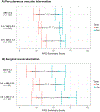Heterogeneity of Ankle-Brachial Indices in Patients Undergoing Revascularization for Critical Limb Ischemia
- PMID: 29169498
- PMCID: PMC6800014
- DOI: 10.1016/j.jcin.2017.08.026
Heterogeneity of Ankle-Brachial Indices in Patients Undergoing Revascularization for Critical Limb Ischemia
Abstract
Objectives: This study sought to describe the distribution of pre-intervention treated-limb ankle-brachial indices (ABIs) among patients with critical limb ischemia (CLI) undergoing percutaneous vascular intervention (PVI) or surgical revascularization (SR).
Background: CLI is diagnosed by the presence of rest pain, tissue ulceration, or gangrene due to chronic arterial insufficiency. It is unclear what fraction of patients with suspected CLI have severe peripheral artery disease (PAD) on noninvasive functional testing.
Methods: The study included patients who underwent lower extremity revascularization for CLI in a multicenter registry in Michigan from January 2012 through June 2015. ABIs were classified as normal (ABI: 0.91 to 1.40), mild-moderate (ABI: 0.41 to 0.90), and severe (ABI: ≤0.40). Pre- and post-intervention Peripheral Artery Questionnaire summary scores were assessed in a subset of patients.
Results: Among 10,756 patients with signs or symptoms of CLI, 9,113 (84.7%) underwent PVI and 1,643 (15.3%) underwent SR. ABIs were recorded in 4,972 (54.6%) PVI and 1,012 (61.6%) SR patients. Patients undergoing PVI had higher ABIs than those undergoing SR, with substantial variation in both groups (PVI: 0.72 ± 0.29 vs. SR: 0.61 ± 0.29; p < 0.001). Nearly a quarter of patients with compressible arteries had normal ABIs (24.0%), whereas severe PAD was uncommon (16.5%). A significant improvement in Peripheral Artery Questionnaire scores was noted after intervention across all ABI categories.
Conclusions: Among patients undergoing revascularization for CLI in contemporary practice, the authors found substantial heterogeneity in pre-intervention ABIs. The disconnect between ABI results and clinical diagnosis calls into question the utility of ABIs in this population and suggests the need for standardization of functional PAD testing.
Keywords: ankle-brachial index; critical limb ischemia; percutaneous vascular intervention; peripheral artery disease; surgical bypass graft.
Copyright © 2017 American College of Cardiology Foundation. Published by Elsevier Inc. All rights reserved.
Figures



Comment in
-
Time to Redefine Critical Limb Ischemia.JACC Cardiovasc Interv. 2017 Nov 27;10(22):2317-2319. doi: 10.1016/j.jcin.2017.09.012. JACC Cardiovasc Interv. 2017. PMID: 29169499 No abstract available.
Similar articles
-
Non-compressible ABIs are associated with an increased risk of major amputation and major adverse cardiovascular events in patients with critical limb ischemia.Vasc Med. 2017 Jun;22(3):210-217. doi: 10.1177/1358863X16689831. Epub 2017 Mar 20. Vasc Med. 2017. PMID: 28466753
-
Current accepted hemodynamic criteria for critical limb ischemia do not accurately stratify patients at high risk for limb loss.J Vasc Surg. 2016 Jan;63(1):105-12. doi: 10.1016/j.jvs.2015.07.095. Epub 2015 Sep 26. J Vasc Surg. 2016. PMID: 26412436
-
Complete Lower Extremity Revascularization via a Hybrid Procedure for Patients with Critical Limb Ischemia.Vasc Endovascular Surg. 2018 May;52(4):255-261. doi: 10.1177/1538574418761723. Epub 2018 Feb 27. Vasc Endovascular Surg. 2018. PMID: 29486676
-
Contemporary Management of Critical Limb Ischemia.Adv Surg. 2018 Sep;52(1):257-274. doi: 10.1016/j.yasu.2018.03.012. Epub 2018 Jun 19. Adv Surg. 2018. PMID: 30098617 Review. No abstract available.
-
Characteristics of peripheral arterial disease and its relevance to the diabetic population.Int J Low Extrem Wounds. 2011 Sep;10(3):152-66. doi: 10.1177/1534734611417352. Epub 2011 Aug 19. Int J Low Extrem Wounds. 2011. PMID: 21856972 Review.
Cited by
-
Limb Perfusion During Exercise Assessed by Contrast Ultrasound Varies According to Symptom Severity in Patients with Peripheral Artery Disease.J Am Soc Echocardiogr. 2019 Sep;32(9):1086-1094.e3. doi: 10.1016/j.echo.2019.05.001. Epub 2019 Jun 22. J Am Soc Echocardiogr. 2019. PMID: 31235422 Free PMC article.
-
Standardization and clinical applications of retinal imaging biomarkers for cardiovascular disease: a Roadmap from an NHLBI workshop.Nat Rev Cardiol. 2025 Jan;22(1):47-63. doi: 10.1038/s41569-024-01060-8. Epub 2024 Jul 22. Nat Rev Cardiol. 2025. PMID: 39039178 Review.
-
Skeletal muscle regeneration failure in ischemic-damaged limbs is associated with pro-inflammatory macrophages and premature differentiation of satellite cells.Genome Med. 2023 Nov 10;15(1):95. doi: 10.1186/s13073-023-01250-y. Genome Med. 2023. PMID: 37950327 Free PMC article.
-
Establishing Thresholds for Minimal Clinically Important Differences for the Peripheral Artery Disease Questionnaire.Circ Cardiovasc Qual Outcomes. 2021 May;14(5):e007232. doi: 10.1161/CIRCOUTCOMES.120.007232. Epub 2021 May 5. Circ Cardiovasc Qual Outcomes. 2021. PMID: 33947205 Free PMC article. Clinical Trial.
-
SCAI/ACR/APMA/SCVS/SIR/SVM/SVS/VESS Position Statement on Competencies for Endovascular Specialists Providing CLTI Care.J Soc Cardiovasc Angiogr Interv. 2022 Feb 14;1(3):100015. doi: 10.1016/j.jscai.2021.100015. eCollection 2022 May-Jun. J Soc Cardiovasc Angiogr Interv. 2022. PMID: 39131959 Free PMC article. No abstract available.
References
-
- Allison MA, Ho E, Denenberg JO et al. Ethnic-specific prevalence of peripheral arterial disease in the United States. Am J Prev Med 2007;32:328–33. - PubMed
-
- Mozaffarian D, Benjamin EJ, Go AS et al. Heart Disease and Stroke Statistics-2016 Update: A Report From the American Heart Association. Circulation 2015. - PubMed
-
- Criqui MH, Aboyans V. Epidemiology of peripheral artery disease. Circ Res 2015;116:1509–26. - PubMed
-
- Fowkes FG, Rudan D, Rudan I et al. Comparison of global estimates of prevalence and risk factors for peripheral artery disease in 2000 and 2010: a systematic review and analysis. Lancet 2013;382:1329–40. - PubMed
-
- Gerhard-Herman MD, Gornik HL, Barrett C et al. 2016 AHA/ACC Guideline on the Management of Patients With Lower Extremity Peripheral Artery Disease: Executive Summary: A Report of the American College of Cardiology/American Heart Association Task Force on Clinical Practice Guidelines. Circulation 2016. - PMC - PubMed
Publication types
MeSH terms
Grants and funding
LinkOut - more resources
Full Text Sources
Other Literature Sources
Medical
Research Materials
Miscellaneous

